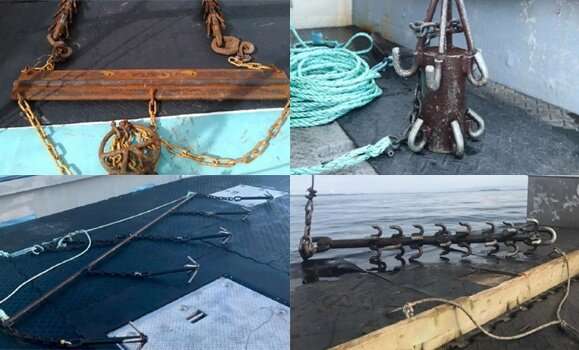Examples of grapples used for gear retrieval during retrieval efforts for recovering lost or abandoned fishing gear. Credit: Coastal Action photos
Southwest Nova Scotia is one of Canada's most productive lobster fishing region, spanning more than 21,000 square kilometers and contributing a significant portion of the country's lobster supply.
With a busy fishery, though, has come the growing challenge of abandoned, lost and discarded fishing gear (ALDFG)—a collection of traps, ropes, hooks, cables and other fishing-related equipment that drift through the water column or litter the ocean floor. It is a global problem, but one that hasn't been widely quantified.
Researchers at Dalhousie University wanted to find out how much gear might be in the Southwest Nova Scotia (SWNS) fishing zone and how it might be affecting the existing fishery. Their recently published baseline study provides the first preliminary assessment of environmental and economic impacts of ALDFG on the commercial lobster industry in the area.
Significant impact
Tony Walker, an associate professor in Dal's School for Resource and Environmental Studies, co-authored the paper, which suggests the commercial losses from ALDFG could be in excess of $175,000 (Cdn) annually.
"This study is important because although we have known about the problem of ALDFG or ghost gear and were aware of where the hot spots are in the region, this is the first time that a systematic project has focused and targeted on retrieving the gear, while simultaneously quantifying the environmental and economic impacts," says Dr. Walker.
"This tells us that there are not only obvious environmental impacts of leaving this gear in place, but it also highlights the potential economic losses that can be incurred without mitigative or policy action."
Fishers did 60 retrieval trips in the summer and fall of 2020, searched roughly 1,523 square kilometers of the seafloor and removed 7,064 kilograms of ALDFG. Captains towed grapples behind their commercial fishing vessels from either a hydraulic hauler and winch or a steel cable dragger and A-frame winch, at a speed of 0.5 to 3 knots.
Lobster traps made up the majority of retrieved gear, while 1,500 kilograms of dragger cable comprised 22 percent of the recovered gear. Lost traps continued to capture 15 target and non-target species, including 239 lobsters and seven groundfish. Five of those were species-at-risk and included Atlantic wolfish, sculpin, Atlantic cod and cusk.
Tires, party balloons, a fan belt and buoys with U.S. markings were also recovered.
Hazards and concerns
About 35 percent of the recovered traps were less than three years old and based on the quantity of cable recovered, the authors suggest that cable is discarded by commercial trawl vessels or draggers when it is no longer of use. In Atlantic Canadian trap fisheries, it's estimated that up to two percent of total allowable traps are lost annually.
"This may create operational hazards for other commercial vessels (lobster or groundfish) as it may compromise active gear, create marine debris and disturb sensitive benthic habitats," states the study, which was also authored by Alexa Goodman, Ariel Smith and Jessie McIntyre of Coastal Action, and Craig Brown and Leah Fulton of Dal's Department of Oceanography.
It also sets off an endlessly destructive cycle as cod, cusk, wolffish and sculpin are known lobster predators and are frequently caught as by-catch in active lobster fishing gear. Traps retrieved with these by-catch fish also contained lobster, indicating the self-baiting cycle of ghost gear. Self-baiting occurs when animals become trapped in ALDFG and die, attracting new scavengers that also become trapped, says the report.
The oldest trap found was from 1987, while most retrieved gear was not highly degraded, losing less than 25 percent of its original integrity.
A global problem
It's estimated that abandoned, lost, and discarded fishing gear makes up a significant majority of the 20 percent of the world's marine debris. For example, discarded fishing nets account for over 46 percent of debris in the Great Pacific Garbage Patch.
"ALDFG is unfortunately a pervasive global problem. Many people may be unaware that much of the global plastic pollution found in our oceans is comprised of ALDFG," says Dr. Walker.
"While this study focused on SWNS, results are comparable to similar fisheries in the US, Europe and South America."
Other jurisdictions are also grappling with the problem. In the U.S. Chesapeake Bay blue crab fishery, an estimated 18 crabs were killed per derelict pot annually. The Florida Keys' spiny lobster fishery has recorded smaller losses to derelict traps, but studies suggest that estimates of lobster by-catch rates could potentially be two to four times lower than true levels of ghost fishing.
Provided by Dalhousie University
























